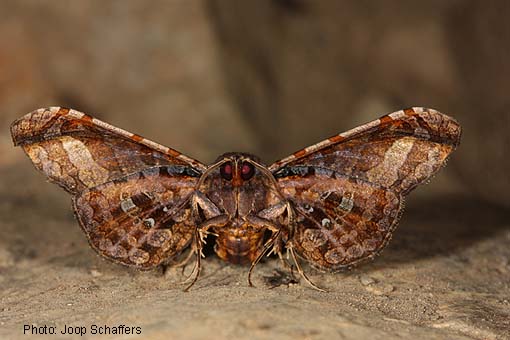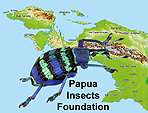



March 2009
other issues of our Newsletter:
August 2008 - November 2009 - October 2010 - December 2011
Papua-Insects.nl
The Papua Insects Foundation
The latest news on the Papua Insects Foundation and the website
In this newsletter we want to inform you about the latest developments and changes. If you have any questions or comments on this, please contact us.
The second issue of SUGAPA has been released
This new entomological magazine is continued, now the second issue has been released: 3 (2). SUGAPA is a continuation of the newsletter "SUGAPA" of the Kelompok Entomologi Papua (KEP) which started in July 2006 and since then published 8 issues on the activities of the members of KEP, a group of enthousiast Papuan biology students and teachers of the Cenderawasih University (UNCEN), with Henk van Mastrigt as guide and teacher. Initially the language in the newsletter was Bahasa Indonesia, which was a problem for most interested scientist. The Papua Insects Foundation therefore presented English translated abstracts on the website.
The magazine SUGAPA will focus on international scientists and deal with subjects on Papuan insects. The text will be mostly in English (about 25 % will be in Bahasa Indonesia). More information or subscription
The editors of SUGAPA appeal for entomologists to contribute in their journal, so if you have manuscripts (almost) ready on Papuan insects and want to publish in SUGAPA, please contact the editorial board of SUGAPA.
We like to emphasize that SUGAPA is a registered journal (ISSN 1978-9807) and independently founded by KEP, but it is obvious that the Papua Insects Foundation fully supports this initiative with what we can.
The second issue contains:
Introduced species of Lepidoptera in Papua - Henk van Mastrigt
Revision of Delias mysis (Fabricius, 1775) and closely related species (Lepidoptera: Pieridae) - Chris Davenport & Henk van Mastrigt
Visit to Papua in October 2008
In August 2008 we announced that almost the full board of the Papua Insects Foundation would pay a visit to Papua in October of that year. The visit was very useful, we met the biology students of UNCEN in Waena again and made some field trips together with them. We also met Neville Kemp and Bruce Beehler of Conservation International with whom we will keep contact about future projects.
Supiori Island
One of our visits was on the northside of Supiori Island, Northwest of Biak. Although a ring road around the island is being made, it was a pleasant surprise to us to see that most of the island is still covered by primary forest. Attemps are made to cut roads to the inside of the island but so far these are not yet numerous and far from complete. Of course it is just a matter of time until the island will be explored and cultivated, unless the official status of National Reserve. Therefore we should give logging and destroying the rainforest no chance and insist upon protection of the island's nature by the Indonesian government.
The northcoast of Supiori is dominated by Mangrove forests interrupted by some small villages settled at the coast. A totally new capital city has been build in the northeast which is still uninhabited, because people rather live in their familiar village with their own poor houses.
Mangrove forest at the northcoast of Supiori (photos: Rob de Vos)
The insect life is still flourishing in the forests. Some conspicuous and common species are Ornithoptera priamus (Lepidoptera: Papilionidae), Eupholus magnificus (Coleoptera: Curculionidae) and Acherontia lachesis (Lepidoptera: Sphingidae). We were lucky to have Joop Schaffers with us on our trip, who is an enthousiast macro-photographer. Many of the insects seen during the day or attracted to light in the evening were captured with his camera, and when suitable also collected by us.
Lelambo
A four-day visit was made by three members of our survey team to the tiny village of Lelambo (Kabupaten Yahukimo), which lies at an altitude of 900 meter at the north side of the Jayawijaya Mountains. No entomological fieldwork had been undertaken at this site before. The area is surrounded by undisturbed forest and is rich in streams and runnels. From the short visit it is clear that the area is interesting and deserves more fieldwork. During three evenings insects were collected at light and during daytime dragonflies were collected.
Scenes at Lelambo, Jayawijaya Mountains (2008) (photos: Vincent Kalkman)
Walmak
For the second time we paid a visit to Walmak, a small mountain village in District Nipsan (Kabupaten Yahukimo). We have been there before in 2005 and the reason for our return was that particular this locality was a very successful one concerning collecting at light. And again Walmak proved to guarantee a very successful collecting site. We now went in another period of the year which resulted in many different species compared to 2005 and, as we yet can overview, also with many new species for science.
Scenes at Walmak, Jayawijaya Mountains (2008)
During day trips and collecting at light our photographer Joop Schaffers made many pictures of moths and other insects which will be presented in the website when appropriate (examples are shown here in this news letter). The collected material is at this moment sorted and mounted and some specimens even already are being described.
News on the website
On the homepage you'll find the familiar red button,
. This will bring you to the page with a list of new items or important additions to the website and some important relevant news flashes picked up from the media.
The new items will be mentioned for about half a year in this list and are linked to the actual pages. Regularly checking the "what's new" list keeps you informed about the developments in the website.
The presented list at the moment is as shown below:
- SUGAPA, a new journal on the insects of Papua Indonesia!
- Suara Serangga Papua: Abstracts of SUGAPA 3(2)
- Insect pages:
- Coleoptera: Curculionoidea, Curculionidae (Alexander Riedel)
- Coleoptera: Curculionoidea, Brachyceridae (Alexander Riedel)
- Coleoptera: Curculionoidea, Dryophthoridae (Alexander Riedel)
- Coleoptera: Curculionoidea, Erirhinidae (Alexander Riedel)
- Coleoptera: Curculionoidea, Brentidae (Alessandra Sforzi) New!!
- Hemiptera: Heteroptera, Miridae (Katrina Menard)
- Hymenoptera:Hymenoptera, Apidae: Meliponini (Claus Rasmussen)
- Lepidoptera: Noctuidae (Cocytiinae and Eucocytiinae) (Alberto Zilli)
- Lepidoptera: Noctuidae (Plusiinae) (Laszlo Ronkay) New!! now with species pages
- Lepidoptera: Noctuidae (Agaristinae) (Rob de Vos)
Appeal for more information on other insect groups
At the moment we have contact with about 49 entomologists in the world who more or less contribute to our website or promissed to do so. We would appreciate your cooperation to provide us of information and checklists of your specialism concerning New Guinea in general or Papua Indonesia in particular. If you know of some other specialists who potentially could be interested to contribute to our website, please let him/her know of us or inform us.
We rely on you!